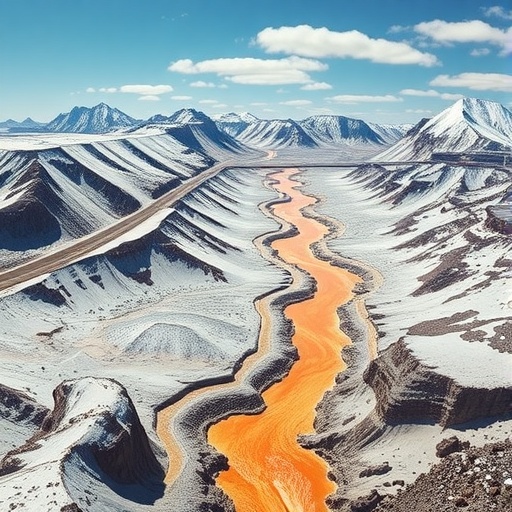
In the wake of catastrophic earthquakes, one of the most insidious and long-lasting consequences comes not from the immediate shaking itself, but from the vast amounts of sediment displaced into river systems. A groundbreaking new study focusing on the 2008 magnitude 7.9 Wenchuan earthquake in the eastern Tibetan mountains sheds critical light on how sediment fluxes within rivers can dramatically increase and persist for extended periods after such seismic events. This research not only refines our understanding of sediment transport following major landslides triggered by earthquakes but also reveals the profound implications for downstream ecosystems and human settlements.
Earthquakes have long been recognized as prime drivers of widespread landslides in mountainous terrains, rapidly mobilizing immense quantities of soil and rock. These landslides feed sediments into river channels, unleashing cascades of fluvial hazards including aggradation, flooding, and habitat disruption. However, an accurate quantification of sediment fluxes, particularly bedload—the sediment transported by rolling or sliding along the river bed—has remained elusive. This scarcity of data has limited our ability to model and predict the evolution of riverine landscapes post-earthquake, making it challenging to design mitigation strategies for affected regions.
In this context, the study offers a comprehensive source-to-sink sediment budget following the Wenchuan earthquake, meticulously tracking the pathways and fate of earthquake-triggered landslide debris across a decade. Central to this endeavor is the measurement of sediment accumulation in a man-made reservoir positioned downstream of the earthquake-impacted catchment. This reservoir acts as a natural sediment trap, allowing researchers to precisely estimate the volume and timing of sediment deposition over time.
.adsslot_5RV0FLXrAN{width:728px !important;height:90px !important;}
@media(max-width:1199px){ .adsslot_5RV0FLXrAN{width:468px !important;height:60px !important;}
}
@media(max-width:767px){ .adsslot_5RV0FLXrAN{width:320px !important;height:50px !important;}
}
ADVERTISEMENT
Remarkably, the findings reveal that even ten years after the seismic event, the Min Jiang River transported only about 9% of the total sediment mass generated by earthquake-triggered landslides. This statistic alone underscores the inertia of sediment stored in mountainous landscapes and the protracted timeline over which rivers cleanse themselves after disturbance. Despite this relatively modest export, the river experienced a sustained 5.7-fold increase in total sediment flux compared to pre-earthquake conditions, meaning sediment transport rates were dramatically elevated over an entire decade.
Delving deeper into sediment dynamics, the researchers disentangled the contributions of suspended load—fine sediments carried within the water column—from those of bedload. They found with high confidence that bedload flux increased by approximately 27.4%, with error margins accounting for natural uncertainty. More strikingly, bedload constituted a dominant 65% of the post-earthquake sediment export, a proportion notably higher than what is typical for most mountainous rivers worldwide, where suspended load tends to dominate.
This dominance of bedload flux post-earthquake has far-reaching consequences for river morphology and flood risk. Bedload transport tends to reshape riverbeds more aggressively than suspended sediments, influencing channel roughness, sediment storage, and the formation of bars and islands. Such geomorphological changes can increase the susceptibility of river systems to blocking and overflow during high-flow events, creating persistent vulnerabilities downstream even long after the initial earthquake has passed.
The study’s projections suggest that at the current sediment transport pace, the river system will gradually wash away the bulk of landslide debris over centennial timescales. In other words, the sediment pulse generated by Wenchuan’s seismic disruption will reverberate through the landscape for generations, with widespread implications for riverine ecology and human livelihoods. This long tail of sediment export challenges prior assumptions that landscapes heal quickly after earthquakes, bringing into focus the importance of long-term monitoring and management.
However, the researchers caution that sediment export rates are unlikely to remain static. Vegetation regrowth on hillslopes, changes in precipitation patterns, and evolving sediment characteristics all could modulate fluxes in the coming decades. For instance, revegetation may stabilize slopes and reduce landslide frequency, while changing monsoon regimes could either amplify or suppress sediment mobilization during floods. Such complex interactions underscore that sediment dynamics in post-earthquake settings are subject to competing and time-varying influences.
Moreover, the study highlights the potential for cascading hazards triggered by the sustained elevated sediment flux. Sediment aggradation—where riverbeds rise due to accumulated sediment—may elevate flood risk, particularly in populated downstream areas where infrastructure and agriculture are vulnerable. Understanding the nature and duration of these sediment pulses is therefore critical for disaster preparedness, urban planning, and ecosystem conservation in seismically active mountainous regions.
What sets this research apart is the decade-long temporal coverage and the integrated source-to-sink approach, which bridges the gap between immediate landslide inventories and the eventual fate of sediment in downstream channels. By combining field data from reservoirs with hydrological and geomorphological analysis, the study provides a rare quantitative window into sediment budgets after a major earthquake, moving beyond snapshot observations to reveal enduring landscape transformations.
Ultimately, this work compels scientists, engineers, and policymakers to reconsider how they assess earthquake impacts on hydrological systems. It highlights the necessity of integrating sediment transport studies into seismic hazard frameworks and river management strategies. In a world where human populations increasingly occupy hazard-prone mountain foothills, understanding the persistence of earthquake-triggered sediment pulses is essential for safeguarding communities and ecosystems.
The revelation that bedload comprises such a significant proportion of post-earthquake sediment transport challenges prevailing paradigms and may prompt new avenues of research into sediment flux partitioning in other tectonically active areas. Future studies expanding on this methodology could help discern the role of different geologic contexts, climatic regimes, and human interventions in modulating sediment responses.
With climate change poised to alter hydrological cycles worldwide, the interplay between seismic activity and sediment flux could become even more complex. This research thereby lays a critical foundation for anticipating and mitigating compounded natural hazards in mountain river basins, underscoring the intricate connectivity between geophysical events and fluvial processes.
As the sediment continues its slow but inexorable journey downstream, reshaping landscapes and affecting human livelihoods, studies like this are vital in unraveling the long-term consequences of earthquakes beyond the initial shaking, revealing a dynamic and evolving natural hazard landscape to which society must adapt.
Subject of Research: Riverine sediment fluxes and bedload dynamics following earthquake-triggered landslides.
Article Title: Large riverbed sediment flux sustained for a decade after an earthquake.
Article References:
Li, G.K., West, A.J., Jin, Z. et al. Large riverbed sediment flux sustained for a decade after an earthquake. Nature 644, 398–403 (2025). https://doi.org/10.1038/s41586-025-09354-8
Image Credits: AI Generated
DOI: https://doi.org/10.1038/s41586-025-09354-8
Keywords: Earthquake, Wenchuan earthquake, sediment flux, bedload transport, landslides, river morphology, sediment budget, hydrology, fluvial hazards, mountain rivers, geomorphology, natural hazards.
Tags: bedload sediment transport challengesearthquake-induced sediment transportfluvial hazards from earthquakesimplications of sediment displacementlandslides and river ecosystemslong-term sediment flow effectsmitigation strategies for sediment-related hazardspost-earthquake landscape evolutionriver sediment flux after earthquakessediment budget analysis in riverssediment dynamics in mountainous regionsWenchuan earthquake sediment study





